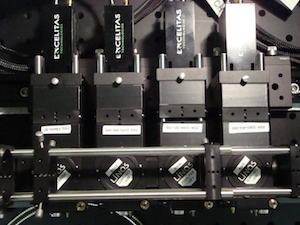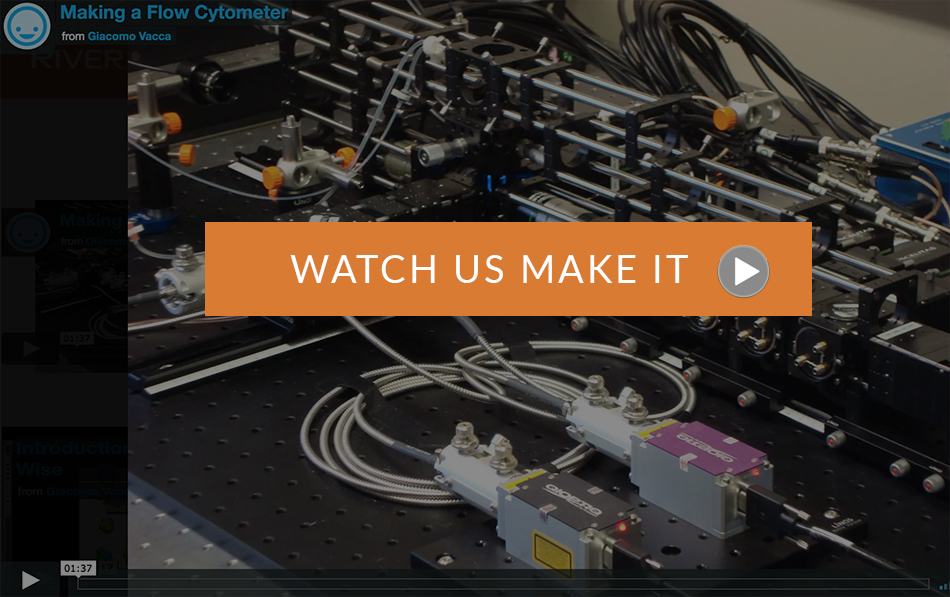“Partnering with Kinetic River for this particular project is the ideal demonstration of this concept based on our combined track record in developing cutting-edge biophotonic systems.”
Michael Ersoni, Excelitas Technologies
EVP, Commercial Strategic Business Unit
Case Study:
Modular Flow Cytometer Prototype
In December 2014, Excelitas Technologies Corporation, a global leader focused on delivering innovative, high-performance, market-driven photonics solutions, decided to demonstrate the practicality of building a complex instrument using off-the-shelf components from its standard offering. The goal was to show the instrument at the SPIE Photonics West conference in February 2015.
Knowing this project faced a very aggressive deadline, Excelitas turned to Kinetic River®, a biophotonics consulting, design, and product development company as a collaboration partner. Kinetic River designed and executed the project leveraging its system design tools and extensive expertise in flow cytometry instrumentation development. The result: a fully functional flow cytometer built from scratch, incorporating Excelitas products for light sources, optics/mechanics, and detection.
Just-in-Time Selection
Excelitas was already familiar with Kinetic River’s proficiency in biophotonics, since Kinetic River had held seminars for Excelitas engineers and managers and presented an overview of instrument optical design for both flow cytometry and non-flow applications. As the 2014 Christmas holidays approached, Kinetic River had only a few weeks to work a rough sketch into a fully operational prototype. Designers wanted to build the optical engine of the instrument almost entirely out of Excelitas components. To ensure the flexibility needed, Kinetic River acquired more than 100 types of components, totaling over 750 individual items, from Excelitas’ extensive technology portfolio. Hundreds of parts per day arrived at the Kinetic River laboratory. “The variety was critical to figure out the layout of the system,” stated Dr. Giacomo Vacca, Kinetic River founder and president.
Excitation optics. The design process began with lasers as excitation sources, incorporating two compact solid-state Qioptiq iFLEX-iRIS™ lasers, one blue and one violet. (The violet laser takes advantage of novel violet-excitable fluorescent dyes recently introduced for flow cytometry.) The iFLEX-iRIS units couple with kineFLEX® fiber optic delivery, allowing them to be positioned some distance from the sample for accessibility and an efficient design. They also simplify the alignment process and make for plug-and-play laser head replacements.
Collection optics. Sets of longpass and bandpass filters ensure the transmission of the appropriate wavelengths of light to the detectors. The optics also include various beam splitters and filters obtained from other sources. Six high-performance Excelitas LynX™ Silicon Photomultiplier Modules (SiPMs) were used for photon detection, one for forward-scatter light (indicative of cell size), one for side-scatter light (indicative of internal complexity), and the other four representing the spectrum emission wavelengths (for fluorescence intensity) based on the lasers selected. SiPMs are photodiode microcell arrays integrated with a power supply and amplifier, and are simpler to integrate than conventional photomultiplier tubes.

Designers ordered a wide array of Excelitas components so everything was on hand to meet project deadlines.

Miniature iFLEX-iRIS™ diode lasers.

LynX™ SiPM detectors.

LINOS Microbench cubes and adapters enabled the designers to suspend the flowcell in a vertical orientation for a perpendicular intersection of the sample stream with the laser beams.
A Well-Managed Design
After experimenting with several options, Kinetic River selected LINOS® Microbench parts from Excelitas’ Qioptiq-Shop.com for organizing the optical bench. Anodized aluminum cubes with stainless steel posts, along with mounting plates, adapters, and connectors, were used with a compatible stainless steel rail system to secure small optical components and create the system layout. Microbench parts assemble and disassemble easily, yet can be stably aligned, so that on-the-fly adjustments to the layout became practical. Cubes could be placed next to one another or stacked, simplified laying out components on all three axes. “Microbench had maximum flexibility for mounting, and we could trust the alignment and stability,” stated Dr. Vacca.
After completing this phase of the design, Dr. Vacca stated, “I have been impressed with Excelitas products. The manufacturing and engineering quality are top notch.”
Fluidics and Data Analysis Complete the System
The fluidic system is powered by a Mitos Duo XS dual syringe pump from Dolomite Microfluidics. This pump, engineered for life science applications, delivers a stable flow at a variety of flow rates, and simplifies system integration by eliminating the need for a separate compressor. A DarklingX Azurite unit manages the data acquisition. This USB-based hardware, designed specifically for flow cytometry applications, measures signals from the detectors and converts data into standard file formats for analysis. Stable and modular, these fluidic and data acquisition components simplified the selection process while ensuring design flexibility.

Syringe pumps drive the fluidics in the system.
Once Designed, Now Validated
Although this project was completed at accelerated speed, Dr. Vacca explains that the process was typical for instrument design. Kinetic River’s work began with simple two-dimensional drawings: “The optomechanical design was very hands-on, sketching out concepts on paper and then immediately verifying them at the bench,” commented Dr. Vacca. However, for key areas involving critical optical performance or physical constraints, Kinetic River used specialized software tools.
Kinetic River used its Live Ideas modeling tool to examine the optical system’s behavior in real time. With this interactive software, designers review simulations on a dashboard to see the impact of potential design changes—for example, beam positions, optical component locations, and nature of the sample flow stream—on key performance parameters. “Live Ideas helped me fix a performance issue, caused by unavailability of a critical component, with minimal redesign and rework,” stated Dr. Vacca.


To simplify the transition from design to implementation, Kinetic River used BeamWise® optical system design tools to verify the physical fit of the components and generate a three-dimensional CAD model of the prototype. Using BeamWise tools, Kinetic River explored “what-if” design scenarios for more advanced design configurations, including a flow cytometer with four laser sources and twelve detectors.
The Design Demonstrated
The system alignment was fine-tuned after assembly using fluorescence dyes and calibration particles. To show that the instrument met specifications, standard fluorescence reference particles were run on the completed system. The Kinetic River – Excelitas Technologies demonstration is being exhibited at trade shows and conferences around the world. As the demonstration shows, it is feasible, using today’s components and tools, to design and build a flow cytometer from scratch in record time with off-the-shelf components. The learning that went into this working prototype will help those building their own complex instruments.

Microscope image of the flowcell where the laser beam (violet)
intersects the sample core stream (green).


